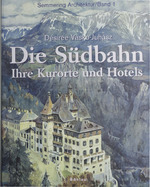Die Südbahn
Ihre Kurorte und Hotels
Author(s)
Vasko-Juhász, Désirée
Contributor(s)
Schwarz, Mario (editor)
Collection
Austrian Science Fund (FWF)Language
GermanAbstract
The present manuscript is intended to be part I of a publication in two volumes, which deals with the historic architecture in the region of "Semmering" in southern Lower Austria from the point of view of art history, cultural history and history of architecture. The study was attempted in continuation of the FWF-project P 13959 under scientifical direction and supervision of the applicant (Prof.Dr. Mario Schwarz). Main topic of this study is the role and importance of the "Suedbahngesellschaft" (Southern Railway Company) in the process of the formation of the Semmering-region as a first-rate holiday resort of the Viennese society during the late 19th century up to the beginning of World War I. The study shows that the forming of this region mainly depended on the initiative of Friedrich Schueler, the Southern Railways Company's director, and Franz Schoenthaler, sculptor in duty of the Imperial Court. The materialization of the planning in the field of hotel-architecture in the first phase was due to architect Franz Wilhelm - collaborator of Wilhelm Flattich, who designed the railway-station of the Southern Railway Company at Vienna, in the second phase due to the architects Alfred Wildhack and Robert v. Morpurgo. The author's research brought a lot of new insight in work and biographies of these architects, who have been neglected so far by the art history. New, important results were achieved by this study concerning the links between the Semmering hotel-architecture and the grand hotel-resorts at Dobiacco (Toblach; architect: Wilhelm Flattich) and Opatija (Abbazia; architect: Alfred Wildhack e.a.), built by the Southern Railway Company as well, which have to be seen as activities in sense of the company's "corporate identity". Thus the company appears among the leading entrepreneurs in the world as founder of railway-hotels. The author presents several famous examples of this kind of hotels from Great Britain to the USA. Here the study is entering a field of architectural research, which still stands at the beginning. There are also important relations between the Semmering hotel-architecture and the historical hotels of Switzerland. In a large panorama the author includes the Semmering hotels in the general regional development of the "Wiener Hausberge" (hills and mountains near Vienna) during the second half of 19th century, especially in the time after the construction of the Semmering railway. The study comprehensively is illustrated with photographs of the object's exteriors and the interiors, historic views, plans and comparative illustrations.
At the beginning of this volume, an introductory chapter, written by the applicant (Prof.Dr.Mario Schwarz), refers on new studies to the phenomenon of landscape aesthetification in view of the construction of the Semmering railway. The main topic is the factor of sensual apperception of the landscape during the continuous movement of a railway-ride and its genial exploitation by the railway's architects. This motivation has to be seen as climax and terminus of a development, which derived from the ideology of English landscape gardening in the age of romanticism. On the other hand the phenomenon is compared with the theories of aestheticism, as they were discussed at the Vienna university in the middle of l9th century. Das vorgelegte Werk ist als 1. Band einer zweiteilig geplanten Publikation verfasst worden, die sich mit den kulturhistorischen und architekturgeschichtlichen Aspekten der Hotel- und Villenbauten am Semmering im südlichen Niederösterreich beschäftigt. Die Arbeit ist eine Fortsetzung eines vom FWF geförderten Forschungsprojekts (Nr. P 13959 ) unter der wissenschaftlichen Leitung und Begutachtung des Antragstellers (Univ.-Prof.Dr. Mario Schwarz). Gegenstand der Untersuchungen und Ausführungen dieses Bandes ist die kulturgeschichtliche Stellung und Bedeutung der Südbahngesellschaft bei der Erschließung der Semmering-Region als erstrangig bedeutendes Naherholungsgebiet des Wiener Bürgertums im späten 19. Jahrhundertwende bis zum Ersten Weltkrieg. Die Untersuchung zeigt, dass die Aufschließung dieses Gebiets hauptsächlich auf die Initiative des Direktors der Südbahngesellschaft Friedrich Schüler sowie auf den Hofbildhauer Franz Schönthaler zurückgeht. Die Umsetzung der Planungen im Bereich der Hotelarchitektur ist in der ersten Phase auf Architekt Franz Wilhelm, den Mitarbeiter des Erbauers des Wiener Südbahnhofes Wilhelm Flattich zurückzuführen, in einer zweiten Phase auf die Architekten Alfred Wildhack und Robert v. Morpurgo. Die Forschungen der Verfasserin erschließen sowohl zu den bisher gänzlich unbearbeiteten Werken dieser Architekten, als auch zu ihren Biographien wichtige Erkenntnisse. Völlig neue, wichtige Ergebnisse brachte die Untersuchung hinsichtlich der Zusammenhänge der Hotelbauten am Semmering mit den großen Hotelanlagen der Südbahngesellschaft in Toblach (Dobiacco; von Wilhelm Flattich) und Abbazia (Opatija; von Alfred Wildhack u.a.) als Aktivitäten einer corporate identity der Bahngesellschaft. Diese Ergebnisse stellen die Südbahngesellschaft mit an die Weltspitze der berühmten Hotelaanlagen von Eisenbahngesellschaften, für die die Autorin zahlreiche Vergleichsbeispiele von Großbritannien bis in die USA anführt. Die Verfasserin erschließt damit den Bereich eines bisher erst in wenigen Ansätzen erforschten Gebiets der Architekturgeschichte. Sowohl vom Ambiente als auch von den gewählten Stileigenschaften der Bauten bestehen jedoch auch wichtige Bezüge der Hotelarchitektur des Semmering zu den Hotelbauten in der Schweiz. In einem großangelegten Überblick bindet die Autorin die Semmeringhotels in die kulturgeschichtliche Entwicklung der Region um die "Wiener Hausberge" in der zweiten Hälfte des 19. Jahrhunderts, insbesondere seit der Erbauung der Semmeringbahn, ein. Die Arbeit ist reich mit Außen- und Innenansichten der Objekte, historischen Ansichten, Plandokumenten und zahlreichen Vergleichsabbildungen ausgestattet.
Dem geplanten Band wird ein Einleitungskapitel des Antragstellers (Univ.-Prof.Dr. Mario Schwarz) vorangestellt, in welchem das Phänomen der Aesthetisierung der Landschaft im Zusammenhang mit der Anlage der Semmeringbahn neu untersucht wurde. Dabei werden vor allem jene Aspekte herausgearbeitet, die die geniale baukünstlerische Einbeziehung des Landschaftsmoments als Erlebnisfaktor aus der Bewegung der Bahnfahrt in das Gestaltungskonzept des Bahnbaues belegen. Die Entwicklung wird einerseits als Höhepunkt und Endpunkt jener Form der Landschaftsgestaltung dargestellt, die aus dem Ideenschatz des Englischen Landschaftsgartens der Romantik hervorgegangen ist, andererseits aber auch mit der um die Mitte des 19. Jahrhunderts in Wien an der Universität gelehrten Theorie der Aesthetik begründet.
Keywords
historic architecture; the region of Semmering; southern Lower Austria; Toblach; VillaDOI
10.26530/oapen_437160Publisher
BrillPublisher website
https://brill.com/Publication date and place
2006Grantor
Imprint
BöhlauClassification
History


 Download
Download